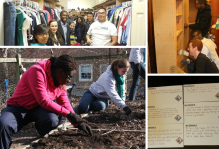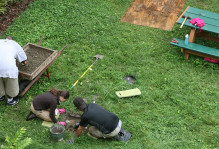The Volunteer Generation Comes to College
In 1993, President Clinton signed into law the National and Community Service Trust Act of 1993 to encourage young Americans to participate in direct community service. As a result more high school age students became involved in community service and arrived at college with at least some experience volunteering in a community setting. Beginning in 1994, the Community Service Provision of the Higher Education Act Amendments of 1992 required all institutions receiving student work-study funds to allocate a minimum of five percent of the funds received to community service placements. At the same time that service driven organizations were building momentum and the federal government was encouraging service involvement, higher education experts were calling on college and university leaders to respond to community needs. Soon after more students were coming to college having volunteered and many of them insisted they they do more. In the years since the manner in which students volunteer has changed dramatically and to an extent we have high schools to thank. Here is what I have found through interviews of students and analysis over my career.
Exposure to and immersion in direct service experiences along with subsequent reflection is the mediating factor for the preparation of college students to develop cognitive skills. In other words, for many, high school service is helping to prepare them for accepting the challenges of coursework in college. Here’s how: Interpersonal, affective development is the precursor for participants’ readiness for cognitive development in a service-learning program. In high school students do not examine the social problems they faced in the community setting in a classroom, so their development consisted of affective development. Course that focus on the examination or social problems are pushing students to develop cognitively through an embedded service-learning approach. Students that have volunteered in high school and have reflected on their place in society appear more equipped for the classroom.
The students I have interviewed share in what appears to be a common developmental sequence related to engagement.
While in high school students had become involved in service as part of a formal or informal obligation. Their motivation rested in fulfilling an obligation to family or school and supporting their personal interests. At some point the service activity became more intense. The intensity of the experience resulted from a connection with recipients of service and prompted the student to reflect on his/her place in society. The students perceived injustice in some manner that challenged his/her frame of reference. This reflection prompted self-examination of identity, which in turn initiated a personal assessment of assumptions about some social issue (e.g., poverty, race, ethnicity and social class). The students felt a range of emotions and thus, a desire to become more involved in service, to do more, and to think more critically about the activity in which he/she was involved. This deeper and more prolonged involvement signals a shift in motivation that occurred prior to college. Upon entering college students might feel a sense of cognitive dissonance. In an effort to resolve the conflict, the students interest in cognitive development was heightened. At William and Mary the Sharpe program provides students with a unique setting in which to work through their beliefs, values and attitudinal struggles.
Upon entering a service-learning program, faculty introduce students to intense service projects. The service-learning environment deepens the students’ commitment to learning about the causes of injustice they witness in the projects by providing a learning environment that stimulates discussion and debate over concerns that do not have simple solutions. Oftentimes students respond favorably to this instructional approach because their previous service experiences and subsequent reflection have positioned them for cognitive challenges.
It appears as though a factor in promoting cognitive development so that students become most interested in service-learning is previous direct service experience that involves an emotional and psychological connection with a community member and the subsequent reflection. This or these early experiences (while building a home, talking with a patient, serving food to a classmate) prompt reflections on one’s place in society and promote a recognition of injustice and feelings of disorientation, frustration, anger, guilt or shame of one’s privileges. The emotional challenge generally begins during a volunteer effort and the student becomes motivated to gather information, acquire knowledge, discuss opposing views, take a stand in opposition of a predominant viewpoint, and consider multiple perspectives on social problems. The affective dimension of development begins in high school, but sometimes absent an environment that encourages cognitive development.




No comments.
Comments are currently closed. Comments are closed on all posts older than one year, and for those in our archive.